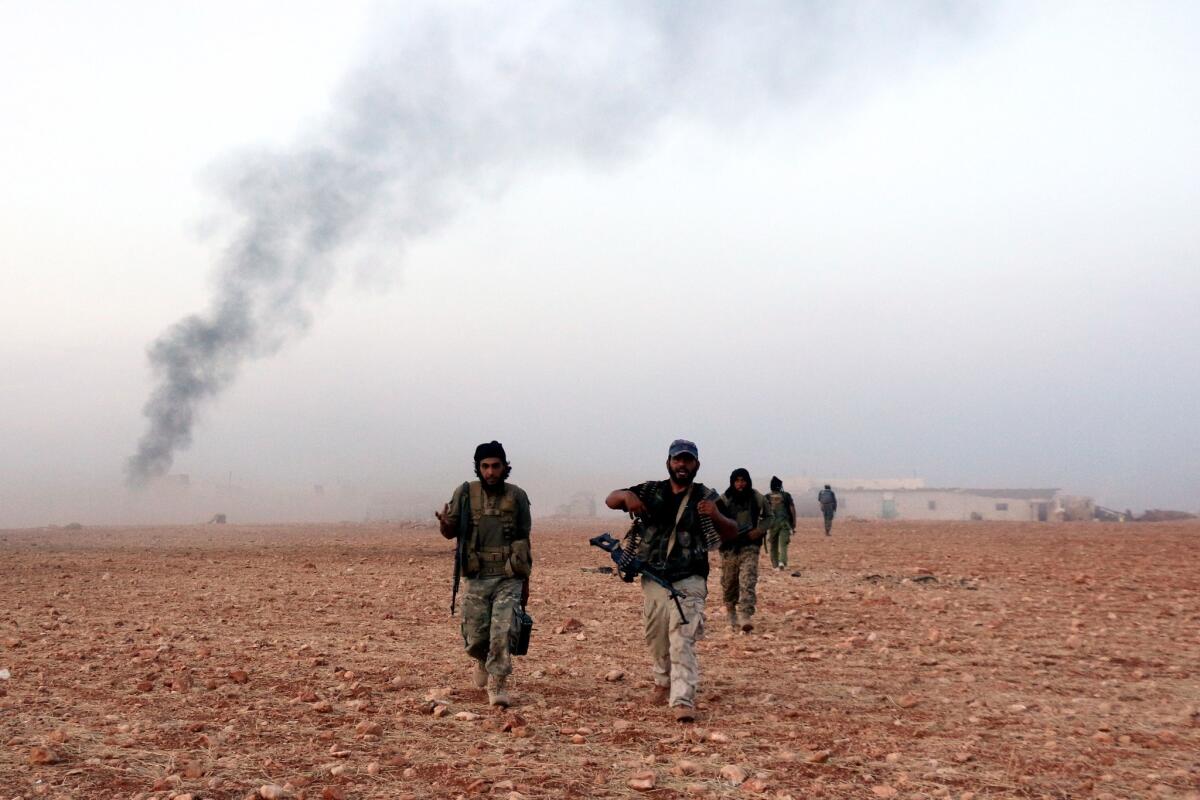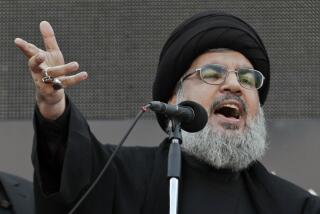Pentagon says airstrike kills Al Qaeda operative in Syria

Syrian opposition fighters in the Mt. Azzan area, outside the northern Syrian city of Aleppo.
- Share via
Reporting from Washington — An airstrike by the U.S.-led coalition in Iraq and Syria has killed Sanafi al-Nasr, leader of an Al Qaeda offshoot called the Khorasan Group and primary coordinator for moving money and fighters to militant strongholds in Syria, the Pentagon said Sunday.
The 30 year-old Saudi-born fighter, also known as Abdul Mohsen Abdallah Ibrahim al Charekh, was killed Thursday in northwest Syria, according to Pentagon spokesman Peter Cook.
Nasr organized routes for new recruits to travel from Pakistan to Syria and helped manage the group’s finances by moving funds from donors into Iraq and then to Al Qaeda leaders.
The Syrian Observatory for Human Rights, a monitoring group based in London, said Nasr was killed near the northern town of Dana, along with another Saudi and a Moroccan member of Al Qaeda’s local affiliate, known as the Nusra Front.
Nasr is the fifth senior Khorasan Group leader killed in the last four months. The Pentagon framed his death as a major loss for Al Qaeda – even though the group has a proven ability to replace leaders quickly.
“The United States will not relent in its mission to degrade, disrupt and destroy Al Qaeda and its remnants,” Defense Secretary Ashton Carter said in a statement. “This operation deals a significant blow to the Khorasan Group’s plans to attack the United States and our allies.”
Nasr was born in Shaqra in Riyadh province inside Saudi Arabia in 1985. His father fought in Afghanistan in the 1980s against the Soviet Union and later encouraged his seven sons to engage in militancy. Two of them later ended up in the Guantanamo Bay detention facility, according to the Combating Terrorism Center at the U.S. Military Academy at West Point, N.Y.
The United Nations Security Council named Nasr to its Al Qaeda sanctions list last year, calling him a “leading terrorist Internet propagandist since 2006.”
He traveled to Iran in late 2008 or early 2009, where he was appointed the Iran-based representative of Al Qaeda, funneling money and fighters for the group. He was arrested by Iranian authorities in 2009 and was released in May 2011 when he traveled to North Waziristan, Pakistan, to develop a new facilitation network.
A year later, he took charge of Al Qaeda’s core finances before relocating to Syria in 2013 with other Al Qaeda fighters, becoming a top strategist in the so-called Khorasan Group.
The Khorasan Group is said to be made up of a shadowy cell of veteran Al Qaeda members with cutting-edge bomb-making abilities who moved to Syria to work undetected by government authorities preoccupied with the civil war there. Their capabilities and the group’s Western recruits, who potentially could cross borders with little scrutiny, are a particularly worrisome combination for U.S. officials.
In July, a U.S. military drone strike in northwest Syria killed Muhsin al-Fadhli, then head of the Khorasan Group.
Follow @wjhenn for military and defense info.
More to Read
Sign up for Essential California
The most important California stories and recommendations in your inbox every morning.
You may occasionally receive promotional content from the Los Angeles Times.











